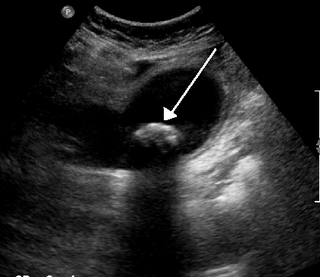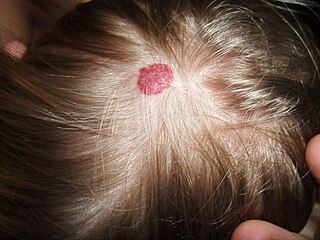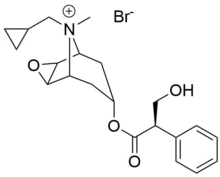
Colic is a form of pain that starts and stops abruptly. It occurs due to muscular contractions of a hollow tube in an attempt to relieve an obstruction by forcing content out. It may be accompanied by sweating and vomiting. Types include:

Osteosclerosis is a disorder that is characterized by abnormal hardening of bone and an elevation in bone density. It may predominantly affect the medullary portion and/or cortex of bone. Plain radiographs are a valuable tool for detecting and classifying osteosclerotic disorders. It can manifest in localized or generalized osteosclerosis. Localized osteosclerosis can be caused by Legg–Calvé–Perthes disease, sickle-cell disease and osteoarthritis among others. Osteosclerosis can be classified in accordance with the causative factor into acquired and hereditary.

Zdravko Čolić is a pop singer from Bosnia and Herzegovina, widely considered as one of the greatest vocalists and cultural icons of former Yugoslavia. Dubbed the 'Tom Jones' of the Balkans he has garnered notoriety in Southeastern Europe for his emotionally expressive tenor voice, fluent stage presence and numerous critically and commercially acclaimed albums and singles.

Pyloric stenosis is a narrowing of the opening from the stomach to the first part of the small intestine. Symptoms include projectile vomiting without the presence of bile. This most often occurs after the baby is fed. The typical age that symptoms become obvious is two to twelve weeks old.

Dicycloverine, also known as dicyclomine, is a medication that is used to treat spasms of the intestines such as occur in irritable bowel syndrome. It is taken by mouth or by injection into a muscle. While it has been used in baby colic and enterocolitis, evidence does not support these uses.

Simeticone (INN), also known as simethicone (USAN), is an anti-foaming agent used to reduce bloating, discomfort or pain caused by excessive gas.

Baby colic, also known as infantile colic, is defined as episodes of crying for more than three hours a day, for more than three days a week, for three weeks in an otherwise healthy child. Often crying occurs in the evening. It typically does not result in long-term problems. The crying can result in frustration of the parents, depression following delivery, excess visits to the doctor, and child abuse.
Colic in horses is defined as abdominal pain, but it is a clinical symptom rather than a diagnosis. The term colic can encompass all forms of gastrointestinal conditions which cause pain as well as other causes of abdominal pain not involving the gastrointestinal tract. The most common forms of colic are gastrointestinal in nature and are most often related to colonic disturbance. There are a variety of different causes of colic, some of which can prove fatal without surgical intervention. Colic surgery is usually an expensive procedure as it is major abdominal surgery, often with intensive aftercare. Among domesticated horses, colic is the leading cause of premature death. The incidence of colic in the general horse population has been estimated between 4 and 10 percent over the course of the average lifespan. Clinical signs of colic generally require treatment by a veterinarian. The conditions that cause colic can become life-threatening in a short period of time.

Neuronal ceroid lipofuscinosis is the general name for a family of at least eight genetically separate neurodegenerative lysosomal storage diseases that result from excessive accumulation of lipopigments (lipofuscin) in the body's tissues. These lipopigments are made up of fats and proteins. Their name comes from the word stem lipo-, which is a variation on "lipid" or "fat", and from the term pigment, used because the substances take on a greenish-yellow color when viewed under an ultraviolet light microscope. These lipofuscin materials build up in neuronal cells and many organs, including the liver, spleen, myocardium and kidneys.
Infantile cortical hyperostosis is a self-limited inflammatory disorder of infants that causes bone changes, soft tissue swelling and irritability. The disease may be present at birth or occur shortly thereafter. The cause is unknown. Both familial and sporadic forms occur. It is also known as Caffey disease or Caffey's disease.
Gripe water is a non-prescription product sold in many countries around the world to relieve colic and other gastrointestinal ailments and discomforts of infants. No evidence supports the efficacy of gripe water and one limited study in India questions whether the consumption of gripe water is related to vomiting in babies that already showed signs of colic. The original formula contained alcohol and sugar in addition to sodium bicarbonate and dill oil. Present-day products do not contain alcohol, and may contain fennel, ginger, chamomile or lemon balm in addition to or replacement for dill oil. Some gripe water products still contain sugar. Some contain charcoal. Amounts given are one to several teaspoons per day.

Biliary colic, also known as symptomatic cholelithiasis, a gallbladder attack or gallstone attack, is when a colic occurs due to a gallstone temporarily blocking the cystic duct. Typically, the pain is in the right upper part of the abdomen. Pain usually lasts from 15 minutes to a few hours. Often, it occurs after eating a heavy meal, or during the night. Repeated attacks are common.
Infantile Progressive Bulbar palsy is a rare type of progressive bulbar palsy that occurs in children. The disease exists in both rapid and slow onsets, and involves inflammation of the gray matter of the bulb. Infantile PBP is a disease that manifests itself in two forms: Fazio Londe syndrome (FL) and Brown-Vialetto-Van-Laere syndrome (BVVL).

Tripeptidyl-peptidase 1, also known as Lysosomal pepstatin-insensitive protease, is an enzyme that in humans is encoded by the TPP1 gene. TPP1 should not be confused with the TPP1 shelterin protein which protects telomeres and is encoded by the ACD gene. Mutations in the TPP1 gene leads to late infantile neuronal ceroid lipofuscinosis.

X-linked spinal muscular atrophy type 2, also known as arthrogryposis multiplex congenita X-linked type 1 (AMCX1), is a rare neurological disorder involving death of motor neurons in the anterior horn of spinal cord resulting in generalised muscle wasting (atrophy). The disease is caused by a mutation in UBA1 gene and is passed in a X-linked recessive manner by carrier mothers to affected sons.
Infantilization is the prolonged treatment of one who has a mental capacity greater than that of a child as though he or she is a child. When used in reference to teenagers or adolescents, the term typically suggests that teenagers and their potential are underestimated in modern society, and/or that adolescents are often regarded as though they are younger than their actual age.
BioGaia is a Swedish biotechnology company that develops, markets and sells a range of products with probiotics.

Infant crying is the crying of infants as a response to an internal or external stimulus. Infants cry as a form of basic instinctive communication. Essentially, newborns are transitioning from life in the womb to the external environment. Up to 27% of parents describe problems with infant crying in the first four months. Up to 38% identify a problem with their infant crying within the first year. Parents can be concerned about the amount of time that their infant cries, how the infant can be consoled, and disrupted sleeping patterns. Colic is used as a synonym for excessive crying of infants, even though colic may not be the cause of excessive crying.

A hemangioma or haemangioma is a usually benign vascular tumor derived from blood vessel cell types. The most common form is infantile hemangioma, known colloquially as a "strawberry mark", most commonly seen on the skin at birth or in the first weeks of life. A hemangioma can occur anywhere on the body, but most commonly appears on the face, scalp, chest or back. Treatment of a hemangioma is usually unnecessary unless the nodule interferes with vision or breathing, or in rare cases of internal hemangiomas causes or contributes to other medical problems.












